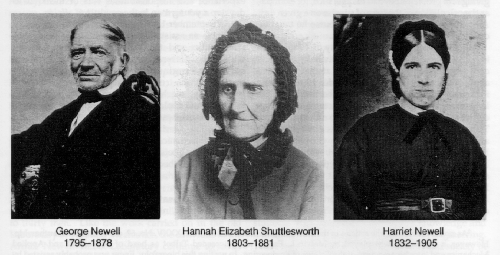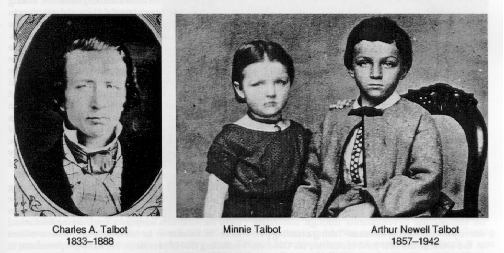
Talbot's Formative Years

His early education was in the school in Cortland, a village about 55
miles west of Chicago, and in the high school at Sycamore. While he
was yet a young lad his grandfather Newell had recognized his
aptitude in mathematical matters and encouraged the boy by giving
him problems beyond his age, such, for example, as the calculation
of the time of sunrise on a given day. After completing his high
school course he taught a country district school for two years.

In 1877 he entered the University of Illinois, then known as the
Illinois Industrial University, to study civil engineering. The
University at that time had about 300 students of collegiate grade.
Here he came in contact with Ira Osborn Baker who had begun his
long career as a teacher of civil engineering three years earlier and
was already beginning to attract attention. Talbot was a brilliant
student; indeed his scholastic average remained the record for many
years. However, he did not devote all of his time and energy to study
but was active in extracurricular activities. He was secretary, vice
president, and president of Philomathean Literary Society, associate
editor of the Illini delegate to the Interstate Oratorical Association,
class essayist, a leading officer in the student
government, the ranking officer in the Cadet Corps, and entered into
other student activities. In addition to these activities, he gave
instruction in preparatory mathematics and in his senior year was a
student assistant in physics.
The literary society was the major student activity during the time
Talbot was a student. He took a prominent part in the Philomathean
Society. The titles of his addresses to the society covered a wide
range of subjects. His commencement oration, delivered in June
1881, was "A Defense of the Public Schools." It cannot be doubted
that his interest in student literary activities and the training he
then received helped to develop the precision and clearness in
speech and writing which has been one of his outstanding
characteristics.
After graduation in June 1881, he went west and was for four years
engaged in railroad location, construction, and maintenance in
Colorado, New Mexico, Kansas, and Idaho. The nature of the
experience and responsibilities was of the kind to develop a young
man in the conduct of affairs.

In September 1885, he returned to the University of Illinois as
assistant professor of engineering and mathematics and taught a
wide range of subjects, which at different times included
mathematics, surveying, engineering drawing, contracts and
specifications, roads and pavements, railroad engineering,
mechanics and materials, hydraulics, tunneling and explosives,
water supply and sewerage. In 1890, his title was made Professor of
Municipal and Sanitary Engineering, in charge of Theoretical and
Applied Mechanics. After the era of expansion in engineering schools
began, mechanics and engineering materials absorbed his attention
even more than sanitary engineering, and without a change in title
the emphasis of his work continued to be placed on mechanics and
materials. For more than forty years he molded and inspired
generations of young men
and was a leader in the development and advances made in this
growing engineering school. Always he regarded teaching as the
important part of his life work. He continued this position until he
reached the age limit of the University in September 1926, when he
retired from teaching and administration and was made Professor of
Municipal and Sanitary Engineering, Emeritus. Since his retirement
he has been actively engaged in directing an extensive research
program.
On June 7,1886, Professor Talbot married Virginia Mann Hammet in
Camargo, 111. She was a classmate and active in student affairs.
She was a member of Alethenai Literary Society, a member of the
college Senate, and president of the Oratorical Association. To them
four children were born: Kenneth Hammet Talbot, engineer, United
States Bureau of Reclamation; Mildred Virginia, wife of Prof. H. J.
Gilkey, Iowa State College, Ames, Iowa; Rachel Harriet, wife of Dean
Harald M. Westergaard, Harvard Graduate School of Engineering,
Cambridge, Mass.; and Dorothy Newell, wife of Mr. Warren F. Goodell,
Loda, 111. Mrs. Talbot was a charming, cultured woman, devoted to
her husband and children. She died December 4, 1919.

![[back arrow]](gifs/leftarrow.GIF)
![[forward arrow]](gifs/rightarrow.GIF)
Biography of Arthur Newell Talbot --
Talbot's Contributions
Table Of Contents
